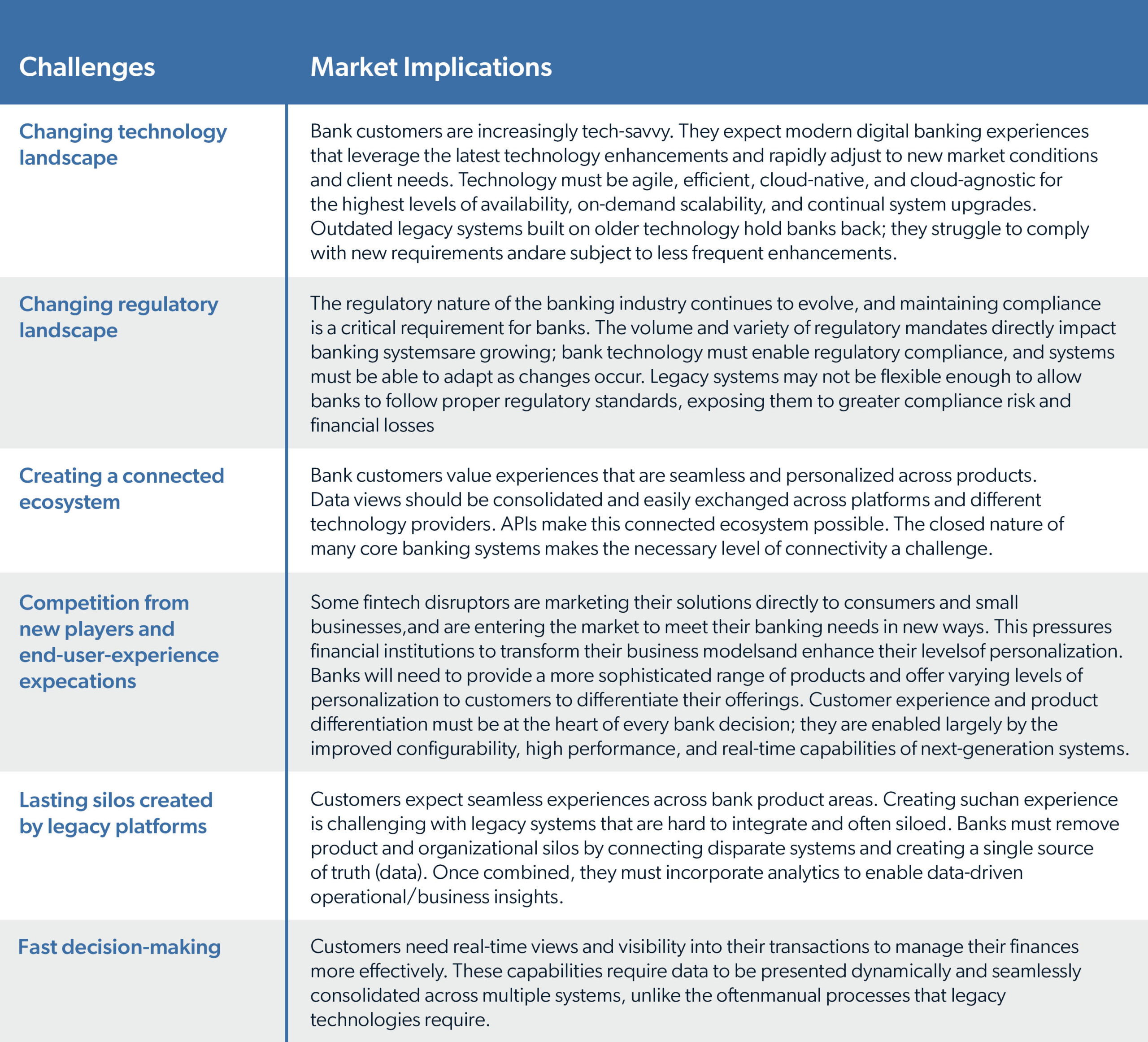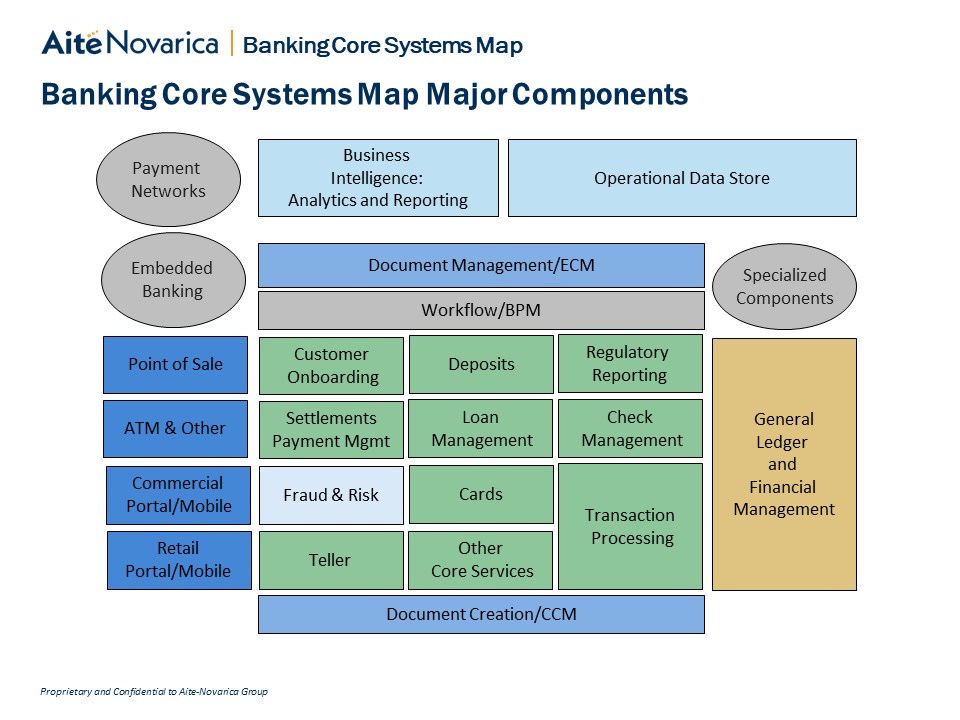 Innovative technologies, increasing competition from nontraditional and fintech players, and heightened customer demands for a seamless digital experience are challenging IT executives in banking organizations to reengineer or modernize their core systems.
Innovative technologies, increasing competition from nontraditional and fintech players, and heightened customer demands for a seamless digital experience are challenging IT executives in banking organizations to reengineer or modernize their core systems.
As a result of these dramatic changes in the industry, banking CIOs and CTOs are leading initiatives to replace core systems and provide customers with the unified digital experience they expect. To execute effectively, it is imperative to have a comprehensive conceptual framework and visual depiction that explains how all solutions are organized within the overall IT system.
Aite-Novarica Group created a proprietary Banking Core Systems Map to facilitate the decisions and trade-offs banking CIOs and CTOs are responsible for making to enhance solutions and applications within an enterprise IT system.
New Core Systems Are Required
In this era of 24/7 digital banking, legacy IT systems or platforms in traditional banks with a web front end are not up to the task of delivering the digital experiences that consumers expect. As I wrote in my recent brief, CIO Checklist: Architecture Considerations for Next-Generation Bank Core Platforms, “Wrapping aged core infrastructures is no longer sustainable; banks have used this approach for decades, but it is quickly coming to the end of its viability.”
Our new Banking Core Systems Map brief outlines six business challenges that are addressed by effectively deploying a new core system.
Table A: Implications of an Evolving Market and Expectations

Aite-Novarica Group’s Core System Map
Aite-Novarica Group’s Core Systems Map provides a comprehensive framework that enables banking IT executives to visualize and leverage a unified, foundational picture of all solutions and applications within an overall IT ecosystem.
Our map is designed to increase effectiveness in developing an enterprise IT strategy, determining the software solutions required when selecting vendors, and making trade-offs when layering on enhanced functionalities to both front- and back-end system components.
While this map is constructed as a generalized reference model*, CIOs and CTOs who are clients of Aite-Novarica Group can use it to support the strategic planning process, to identify trade-offs in implementing the organization’s IT blueprint, and to communicate with the business on how the enterprise IT system needs to evolve.
The Core Systems Map is also an objective check of what a reference architecture should cover; it guides what banking CIOs and CTOs should address in their architecture plan and related IT blueprint such as APIs, open banking principles, data storage and security, and more. It depicts 21 core components of an enterprise IT ecosystem where CIOs and CTOs are responsible for building out and implementing an advanced technologies portfolio to address their key business challenges.
Banking Core Systems Map: Major Components

How to Use the Core Systems Map
IT leaders should first use the map diagram to write in the current solutions, apps, and systems their organization uses in each component to determine redundancies versus gaps as well as where technologies are outdated.
By doing this exercise, CIOs and CTOs can create a complete view of their organization’s current IT state. This then becomes a foundational tool to lead the evolution of an enterprise IT system in two ways:
- Strategic Planning. Adopting a structured approach to evaluate data, digital, and core IT functionalities can help teams develop strategic plans with well-articulated choices for layering in advanced technologies (and selecting providers) over time to modernize core system components.
- Communication. IT teams can leverage the map to educate, guide, and drive alignment with business leaders on IT transformation requirements, trade-offs, budgets, and investment priorities for modernizing the core system and building advanced digital and data analytics capabilities.
Exclusively for FS CIO/CTO Practice Members
Our proprietary Banking Core Systems Map is an exclusive deliverable for IT leaders who are members of Aite-Novarica Group’s new Financial Services CIO/CTO Advisory Practice. Created specifically for technology leaders in banks, payments providers, and securities and investments firms, this new practice is designed to serve as your bridge to relevant C-level insights, decision support, and networking.
The map is a proprietary framework for centering the dedicated stream of best practices and research-based insights, as well as tailored consulting engagements, that we will deliver to member executives.
Interested in how the new FS CIO/CTO Advisory practice can help you and your senior direct reports make better decisions about technology practices and investments to drive greater business impact?
Learn more by reading my practice introduction blog post or email me directly at [email protected].
*A note on methodology: The research methods used to develop the Banking Core Systems Map include best practices learned in discussions from IT executives in banking and insurance. The map also leverages methodologies deployed successfully in financial service firms both large and small. The Banking Core Systems Map framework incorporates approaches used by Aite-Novarica Group to organize enterprise core system vendor evaluations and the development of comprehensive IT strategies and roadmaps that focus on the identification of current state challenges and business goals, a logical blueprint to guide technology development, and a roadmap of technology initiatives sequenced over 3-5 years. Finally, it is also based on the expertise of this author, who held senior C-level technology roles in a large bank and insurance companies in the U.S., U.K., and EU.

